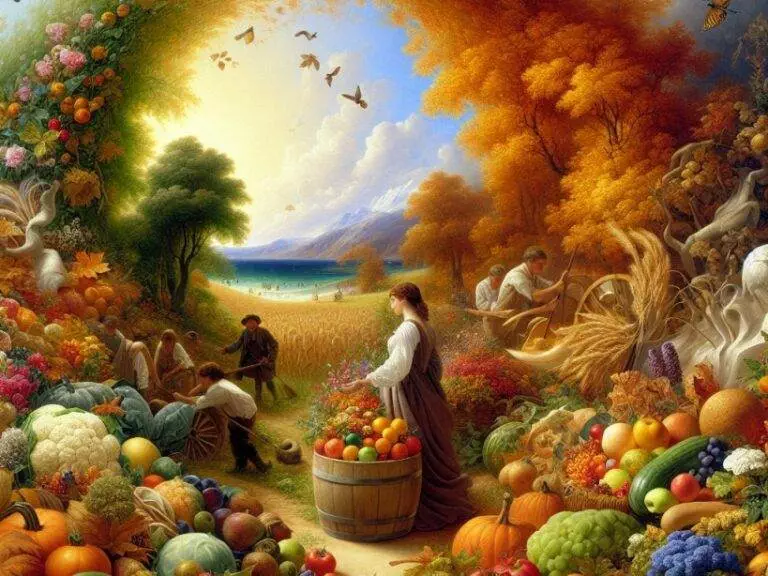Introduction
“To Autumn” is one of the most famous and beloved poems by the English Romantic poet John Keats. Written in 1819, just two years before Keats’ untimely death, the poem is a rich, sensuous meditation on the season of autumn. In this article, we’ll take an in-depth look at the poem, exploring its themes, structure, and language, as well as its enduring legacy in English literature.
Table of Contents
Background on John Keats
John Keats (1795-1821) was one of the most important figures in the English Romantic movement. Despite his short life, Keats produced some of the most memorable poetry in the English language, known for its vivid imagery, sensuous language, and deep reflections on beauty, love, and mortality.
Some key facts about Keats’ life and work:
- Keats was born in London and originally trained as a surgeon before dedicating himself to poetry
- His first published poems appeared in 1816, including the famous sonnet “On First Looking into Chapman’s Homer”
- Keats’ most productive period was 1818-1820, in which he wrote many of his most famous works, including “Ode to a Nightingale,” “Ode on a Grecian Urn,” and “To Autumn”
- Keats battled ill health for much of his life and died of tuberculosis at the age of 25 in Rome
- Although Keats’ work was not widely appreciated in his lifetime, he became recognized as one of the greatest English poets in the late 19th century
Summary of “To Autumn”
“To Autumn” is composed of three stanzas of 11 lines each. The poem personifies autumn as a benevolent figure who brings bounty and beauty to the natural world.
The first stanza describes autumn’s abundance, with “mists and mellow fruitfulness” filling the landscape. Autumn is shown as a collaborator with the sun, ripening fruits and swelling gourds. The second stanza shifts to a more pensive mood, with autumn seen in a moment of rest amidst its labors. Images of harvested grain, cider presses, and gathering swallows evoke a sense of completion and waning.

The final stanza turns to the sounds of autumn, the “music” of gnats, lambs, crickets, and robins. Despite the coming chill of winter, autumn retains its own unique beauty and sound. The poem ends on a note of acceptance, acknowledging that the “soft-dying day” of autumn must yield to the “gathering swallows” of coming winter.
Themes and Meaning of “To Autumn”
Embracing Change and Mortality
One of the central themes of “To Autumn” is the acceptance of change and mortality. Keats wrote the poem in September 1819, while facing his own untimely death from tuberculosis. The poem can be seen as Keats’ attempt to come to terms with his own mortality through the metaphor of the changing seasons.
Just as autumn must give way to winter, Keats recognizes that life must yield to death. Yet the poem suggests that there is beauty and meaning to be found in this process of change and decay. Autumn is portrayed as a rich, fulfilling season in its own right, not merely a prelude to winter. The poem invites us to embrace the present moment and find “ripeness” wherever we are in life’s cycle.
As Keats writes in the first stanza:
Season of mists and mellow fruitfulness,
Close bosom-friend of the maturing sun;
Autumn is a “close bosom-friend” of the sun, working in harmony with it to bring the fruits of the earth to ripeness. Change is portrayed as a natural, even friendly process.
Nature’s Abundance and Regeneration
Another key theme is the abundant, regenerative power of nature. Each stanza is filled with images of nature’s plenty, from the “mossed cottage-trees” bent with apples to the “fume of poppies” and “later flowers for the bees.” Even as autumn moves towards winter, there is a sense of nature’s unstoppable force and ability to renew itself.
The second stanza in particular emphasizes this regenerative aspect, with the personified figure of autumn seen amidst its “store” of harvested grain:
Thy hair soft-lifted by the winnowing wind;
Or on a half-reap’d furrow sound asleep,
Drows’d with the fume of poppies, while thy hook
Spares the next swath and all its twined flowers:
Even in its moment of rest, autumn is surrounded by the fruits of its labor, the “half-reap’d furrow” and the “next swath” waiting to be cut. The cycle of nature continues, with each season playing its part.
Finding Beauty in the Passing Moment
A final key theme is the importance of finding beauty and meaning in transient, passing moments. The poem is filled with images of fleeting beauty, from the “soft-dying day” to the gathering swallows preparing for their migration.
Keats suggests that it is precisely the ephemeral nature of these moments that makes them so precious. By fully immersing ourselves in the sights, sounds, and sensations of the present moment, we can find a deep, sustaining beauty that transcends life’s transience.

The final stanza is especially powerful in evoking this theme:
Where are the songs of Spring? Ay, where are they?
Think not of them, thou hast thy music too,—
While barred clouds bloom the soft-dying day,
And touch the stubble-plains with rosy hue;
Although spring’s joys may have passed, autumn has its own “music,” its own unique beauties. The “stubble-plains” may be a reminder of the coming winter, but they are touched with a “rosy hue” in the waning light. The key is to be present to that beauty while it lasts.
Poetic Devices and Structure in “To Autumn”
Personification
One of the most striking aspects of “To Autumn” is Keats’ use of personification. Autumn is portrayed as a vivid, living figure who presides over the natural world. This personification allows Keats to vividly evoke the sights, sounds, and sensations of the season, as if autumn were a character with agency and personality.
Examples of personification in the poem include:
- “Close bosom-friend of the maturing sun”
- “Thy hair soft-lifted by the winnowing wind”
- “Thou watchest the last oozings hours by hours”
By attributing human qualities and actions to autumn, Keats brings the season to life and engages the reader’s imagination.
Vivid Sensory Imagery
Another key poetic device in “To Autumn” is Keats’ use of rich, sensuous imagery. Each stanza is filled with vivid descriptions that evoke the sights, sounds, smells, and textures of autumn.
For example, in the first stanza, Keats describes how autumn and the sun “load and bless” the vines with fruit:
To bend with apples the moss’d cottage-trees,
And fill all fruit with ripeness to the core;
The sensory language of the “moss’d” trees and fruits filled “to the core” helps the reader vividly imagine the lush abundance of the season.
Other examples of sensory imagery include:
- “Soft-lifted by the winnowing wind”
- “Drows’d with the fume of poppies”
- “Thy hair soft-lifted by the winnowing wind”
- “And full-grown lambs loud bleat from hilly bourn”
Through this vivid imagery, Keats immerses the reader in the physical, sensuous world of autumn.
Structure and Form
“To Autumn” is written in a poetic form Keats himself invented, which is now known as the “Keatsian ode.” Each of the three stanzas follows the same regular pattern of rhyme and meter:
- The first 4 lines of each stanza follow an ABAB rhyme scheme
- The next 7 lines follow a pattern of CDEDCCE
- The meter is a loose iambic pentameter, with 10 syllables per line and an emphasis on every second syllable
This regular structure gives the poem a sense of order and harmony, even as it evokes the changing nature of the season. The three stanzas also build on each other thematically, moving from the initial abundance of autumn to a more pensive reflection on its passing.
Legacy and Influence of “To Autumn”
“To Autumn” has had a profound influence on later poets and artists. Its vivid, sensuous language and themes of mortality, regeneration, and finding beauty in the moment have resonated with readers for over 200 years.
Some key aspects of the poem’s influence and legacy:
- The poem is often seen as one of the most perfect short poems in the English language, admired for its rich imagery, emotional depth, and technical mastery
- “To Autumn” has been widely anthologized and studied in schools and universities as a classic of English Romantic poetry
- The poem’s evocation of the English countryside has made it a beloved seasonal poem, frequently quoted and shared during the autumn months
- Later poets, from the Victorians to the Modernists and beyond, have been inspired by Keats’ vivid imagery and psychological insight
- The poem’s theme of finding meaning and beauty in the face of mortality has made it a frequent choice for memorials and funerals
As one critic has written, “To Autumn” is “an astonishing piece of writing, all the more so because one cannot pin down its achievement to any one thing. It is a poem of perfect poise, perfectly weighted and effortlessly achieved.”
Conclusion
“To Autumn” remains one of the most enduring and beloved poems in the English language. Through its vivid evocation of the sights, sounds, and textures of the season, the poem invites us to fully immerse ourselves in the fleeting beauty of the present moment. At the same time, its reflections on change, mortality, and regeneration continue to resonate with readers facing life’s transience and uncertainty.
Whether we read the poem as a meditation on the natural world, a reflection on the human condition, or simply as a stunning piece of artistry, “To Autumn” has the power to move and inspire us. As Keats writes in the final stanza, autumn’s music and beauty are there for us, if only we take the time to look and listen:
Where are the songs of Spring? Ay, where are they?
Think not of them, thou hast thy music too
In appreciating that music, in finding beauty in the “soft-dying” light of our own autumnal moments, we can achieve a kind of imaginative richness and meaning that transcends life’s fleeting seasons. That is the enduring gift of Keats’ ode “To Autumn.”
Key Takeaways
- “To Autumn” is a lyric poem by John Keats that uses vivid imagery and personification to evoke the sights, sounds, and sensations of the season.
- The poem reflects on themes of change, mortality, nature’s abundance, and finding beauty in transient moments.
- Keats uses a unique structural form in the poem, with each of the three stanzas following a regular rhyme scheme and loose iambic pentameter.
- “To Autumn” has had a profound influence on later poets and has become one of the most memorable and frequently studied poems in the English language.
- The poem continues to resonate with readers as a meditation on embracing life’s changes and finding meaning and beauty in the present moment.
Additional Resources
For more on John Keats and “To Autumn,” check out:


